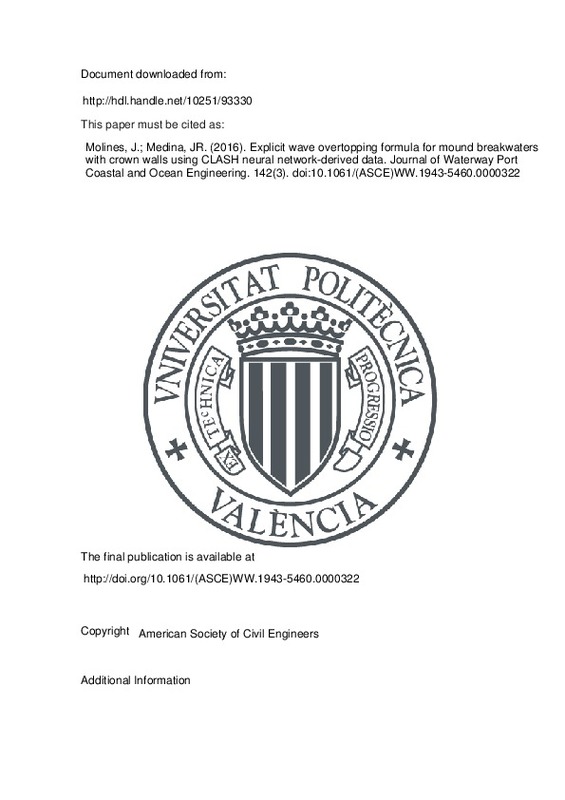JavaScript is disabled for your browser. Some features of this site may not work without it.
Buscar en RiuNet
Listar
Mi cuenta
Estadísticas
Ayuda RiuNet
Admin. UPV
Explicit wave overtopping formula for mound breakwaters with crown walls using CLASH neural network-derived data
Mostrar el registro sencillo del ítem
Ficheros en el ítem
| dc.contributor.author | Molines, Jorge
|
es_ES |
| dc.contributor.author | Medina, Josep R.
|
es_ES |
| dc.date.accessioned | 2017-12-22T07:25:38Z | |
| dc.date.available | 2017-12-22T07:25:38Z | |
| dc.date.issued | 2016 | es_ES |
| dc.identifier.issn | 0733-950X | es_ES |
| dc.identifier.uri | http://hdl.handle.net/10251/93330 | |
| dc.description.abstract | Based on the Crest Level Assessment of Coastal Structures (CLASH) Neural Network Overtopping prediction method, a new 16-parameter overtopping estimator (Q6) was developed for conventional mound breakwaters with crown walls, both with and without toe berms. Q6 was built up using the overtopping estimations given by the CLASH Neural Network and checked using the CLASH database. Q6 was compared to other conventional overtopping formulas, and the Q6 obtained the lowest prediction errors. Q6 provides overtopping predictions similar to the CLASH Neural Network for conventional mound breakwaters but using only six explanatory dimensionless variables (Rc=Hm0; Ir; Rc=h;Gc=Hm0; Ac=Rc, and a toe berm variable based on Rc=h) and two reduction factors (g f and g b ). Q6 describes explicit relationships between input variables and overtopping discharge, and hence it facilitates use in engineering design to identify costeffective solutions and to quantify the influence of variations in wave and structural parameters. | es_ES |
| dc.description.sponsorship | The authors are grateful for financial support from the Spanish Ministerio de Economia y Competitividad (Grant BIA2012-33967). The first author was funded through the FPU program (Formacion del Profesorado Universitario, Grant AP2010-4366) by the Spanish Ministerio de Educacion, Cultura y Deporte. The authors also thank Debra Westall for revising the manuscript. | en_EN |
| dc.language | Inglés | es_ES |
| dc.publisher | American Society of Civil Engineers | es_ES |
| dc.relation.ispartof | Journal of Waterway Port Coastal and Ocean Engineering | es_ES |
| dc.rights | Reserva de todos los derechos | es_ES |
| dc.subject | Wave overtopping | es_ES |
| dc.subject | Mound breakwater | es_ES |
| dc.subject | Neural network | es_ES |
| dc.subject | CLASH database | es_ES |
| dc.subject | Crown wall | es_ES |
| dc.subject | EurOtop | es_ES |
| dc.subject.classification | INGENIERIA E INFRAESTRUCTURA DE LOS TRANSPORTES | es_ES |
| dc.title | Explicit wave overtopping formula for mound breakwaters with crown walls using CLASH neural network-derived data | es_ES |
| dc.type | Artículo | es_ES |
| dc.identifier.doi | 10.1061/(ASCE)WW.1943-5460.0000322 | es_ES |
| dc.relation.projectID | info:eu-repo/grantAgreement/MINECO//BIA2012-33967/ES/ESTABILIDAD HIDRAULICA DE LOS MANTOS DE ESCOLLERA, CUBOS Y CUBIPODOS FRENTE A OLEAJE LIMITADO POR EL FONDO/ | es_ES |
| dc.relation.projectID | info:eu-repo/grantAgreement/MECD//AP2010-4366/ES/AP2010-4366/ | |
| dc.rights.accessRights | Abierto | es_ES |
| dc.contributor.affiliation | Universitat Politècnica de València. Departamento de Ingeniería e Infraestructura de los Transportes - Departament d'Enginyeria i Infraestructura dels Transports | es_ES |
| dc.description.bibliographicCitation | Molines, J.; Medina, JR. (2016). Explicit wave overtopping formula for mound breakwaters with crown walls using CLASH neural network-derived data. Journal of Waterway Port Coastal and Ocean Engineering. 142(3). https://doi.org/10.1061/(ASCE)WW.1943-5460.0000322 | es_ES |
| dc.description.accrualMethod | S | es_ES |
| dc.relation.publisherversion | http://doi.org/10.1061/(ASCE)WW.1943-5460.0000322 | es_ES |
| dc.type.version | info:eu-repo/semantics/publishedVersion | es_ES |
| dc.description.volume | 142 | es_ES |
| dc.description.issue | 3 | es_ES |
| dc.relation.pasarela | S\310161 | es_ES |
| dc.contributor.funder | Ministerio de Economía y Competitividad | es_ES |
| dc.contributor.funder | Ministerio de Educación, Cultura y Deporte | es_ES |







![[Cerrado]](/themes/UPV/images/candado.png)

